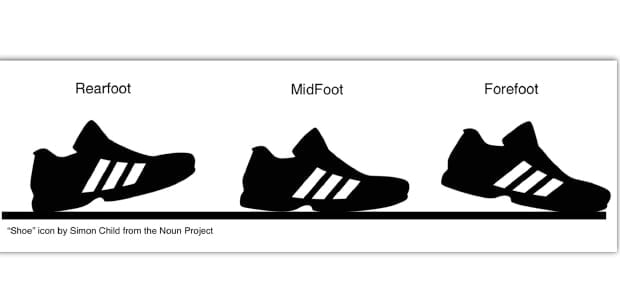Cadence and Foot Strike
Kaitlyn Kakar
PT, DPT, CAFS, CSCS
Spooner Physical Therapy-Desert Ridge
Have you always wanted to start running for exercise or are you currently running, but continue to get injured? Have you spent time trying to diagnose and treat your own injuries, but are overwhelmed by the countless articles and information available on running form, mechanics, and footwear? Well I am here to provide you with a few basic tips from personal and clinical experience to help you improve your running mechanics, reduce your pain, and prevent additional injuries.
Cadence, in relation to running, is the number of stride lengths per minute or frequency at which your foot strikes the ground. The ideal cadence is between 85-90 strides per minute or 170-180 steps per minutes.1 Most runners or joggers fall below this number meaning your stride length is too long or your feet are staying in contact with the ground for too long. In order to increase your cadence, you must shorten your stride length. As you shorten your stride length and increase the frequency at which your foot hits the ground, your foot will spend less time in contact with the ground. This change in stride equates to less strain on your muscles and joints, and therefore, reduces your chance for injury. Research shows “an increased stride rate (reduced stride length) appears to reduce the magnitude of several key biomechanical factors associated with running injuries.”
How do you calculate cadence? The easiest way to measure and track cadence is to use a metronome. There are many free apps available for download on your phone or you can buy one to clip on your shorts. The first step to transitioning to a higher cadence is to measure your current cadence. I would then recommend increasing your cadence two steps per min per week to achieve your ideal cadence between 170-180 steps per minute. Your body needs time to adjust to this new cadence so a gradual transition is important to allow for success and reduce your risk for additional strain or injury if you transition too quickly.
Another important concept is foot strike. Our foot is comprised of 26 bones and more than a 100 muscles, tendons, and ligaments. This dynamic machine is designed to absorb the load of our body as well as propel us forward depending on how our foot is aligned and which muscles are activated. In order to be efficient, we need to use our feet as they were designed. Naturally most people fall into three categories: forefoot, midfoot, or heel strikers. This means when your foot makes contact with the ground your foot lands either on the ball of your foot, around the arch, or at the heel.
A good way to learn how your foot hits the ground is to look at bottom of an old shoe to see where it is the most worn. If you land on your heel, it creates an abrupt stop when your heel hits the ground acting like a brake. This force then travels up to your knee, hip, or even low back requiring another part of your body to absorb the load. This can lead to foot, knee, hip, or low back injuries. On the other hand, forefoot striking requires increased calf activation to maintain the position to land on the ball of your foot. This can lead to calf strains or other overuse injuries in the foot and ankle. Research shows “one can land softly in a midfoot strike without much impact transient, but some midfoot strikes can generate impact transients like those of heel strikes. However, these forces are distributed over larger surfaces areas, reducing the stress on the foot.”3 Landing in a midfoot strike allows for your foot to be in an ideal position, pronation, to absorb shock, and allow for less chance of injury. Similar to cadence, changing the point of foot contact is something to transition into, not something that can happen overnight. Sometimes our feet or ankles lack the proper mobility or stability to allow for successful transition, however, treatment from a physical therapist can help you achieve the mobility and stability you need.
Whether attempting to change your cadence, foot strike, or simply continuing to run, always remember to stretch. Our muscles perform best when they are at an optimum length. Therefore, flexibility is important for performance as well as for injury prevention. If the muscle is too tight it can cause muscle or tendon injuries. The newest research shows that one should perform an active warm-up, stretch, perform the targeted activity, and then stretch again after the activity. Stretching can be dynamic such as hip circles and leg swings or static stretching with a sustained hold for at least 30 seconds. Stretching all major muscles groups including hamstrings, quadriceps, hip flexors, and calves are very important.
Running is a fantastic full body workout. Prior to starting a running program consult your MD. Along your running journey, if any pain or injuries occur, do not hesitate to seek an evaluation from a physical therapist. The sooner you seek treatment, the sooner you will get back to running before causing additional injuries. What can a physical therapist do for you? As the movement specialists of the medical and fitness industry, physical therapists can not only treat your injury, but also teach you strategies for injury prevention, all the while assessing your running mechanics. Come visit me over at Spooner Physical Therapy Desert Ridge location so that you can return to running pain-free.
[1] Dreyer, D. Take your running to the next level with a metronome. ChiRunning. 2012. Available at: http://www.chirunning.com/blog/entry/take-your-running-to-the-next-level-with-a-metronome. Accessed August 8, 2017.
[2] Schubert AG, Kempf J, Heiderscheit BC. Influence of Stride Frequency and Length on Running Mechanics: A Systematic Review. Sports Health. 2014;6(3):210-217. doi:10.1177/1941738113508544.
[3] Lieberman DE, Venkadesan M, Werbel WA, Daoud AI, D’Andrea S, Davis IS, Mang’eni RO, Pitsiladis Y. (2010) Foot strike patterns and collision forces in habitually barefoot versus shod runners. Nature 463: 531-5.
[4] http://www.runningmetronome.org/wp-content/uploads/2013/04/Running-Apps-Running-Cadence.jpg







